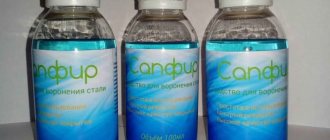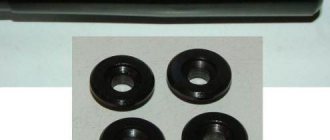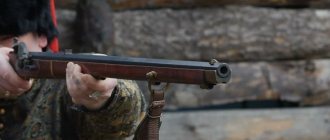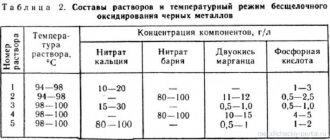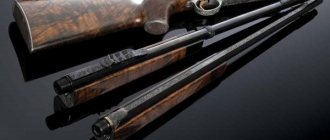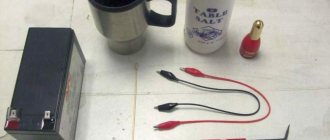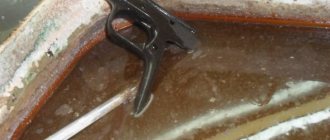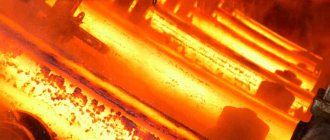There is a misconception that it is impossible to perform [metal bluing at home], and this technical operation, in any case, should only be performed in factories.
Currently, there are several different ways in which you can effectively deal with rusty metal at home.
This type of processing is necessary in order not only to make the metal more attractive.
With its help, the protective properties against corrosion are significantly increased.
Do-it-yourself steel bluing at home is distinguished by simpler methods of metal processing, which use improvised means.
At its core, this method of dealing with rusty metal involves applying a variety of coatings to the surface being treated, which form a thin protective film on it.
At home, this can be done using citric or phosphoric acid, as well as using varnish or oil from which a certain solution is prepared.
Of course, industrial technology allows for better processing, but some methods of dealing with rusty metal at home show quite good results.
What can be achieved by bluing
As a result of chemical or thermal treatment, a layer of iron oxide with a thickness of 1 to 10 microns appears on the surface of a steel part. The thickness of the layer is determined by the selected processing technology.
Blueing of metal allows you to achieve two main goals:
- Increasing the corrosion resistance of the product. Treated parts do not rust.
- Improved appearance. It is especially important for those parts that, due to operating conditions, cannot be painted.
Temperature conditions for bluing
The treatment does not affect other properties of the steel.
Blueing of steel is possible not only in production conditions, but also at home. There are many methods and compositions, almost all of them involve the use of chemically active substances that can cause serious harm to health. To successfully and safely use these substances at home, you must follow the following safety rules:
- Use a protective mask and gloves.
- Ensure ventilation of the room in which work is carried out.
- Use stainless steel utensils.
- Do not exceed the recommended processing temperature.
Process technology
You can often hear the opinion that high-quality bluing is only available in industrial, factory conditions. This is true, but only partially. Yes, in factory conditions, reagents with a much higher content of iron oxide are used for oxidation than can be used at home. It simply will not be possible to bring the substance to the required temperature. But home bluing is almost in no way inferior to factory bluing, provided that high-quality materials and the necessary equipment are used.
For home bluing, one of three methods is usually used:
- Surface treatment with an oxidizing agent. The barrel is coated with a chosen reagent, for example, saltpeter, and reacting with the metal, the saltpeter gives it a black color. The complexity of this technology lies in the fact that before application, the saltpeter will have to be heated to its melting point, which is about 169.6°C and not everyone can do it.
- The most popular method is hot bluing. It is closest to what is used in factories. Another advantage of this method is the complete absence of harmful fumes. The steps are very simple - heat the part as much as possible and immerse it in machine or linseed oil.
- Cold bluing. It is used in cases where the steel does not have high enough strength and can be damaged during the heating process. The cold oxidation process involves treating the part with various reagents that create a protective film on the metal surface. The most important thing is to use protective equipment for the face and hands, and also monitor the time the metal is immersed in the oxidizer.
Another unspoken method of processing weapons that many hunters practice is coating the barrels with “rusty varnish.” We'll tell you more about each method a little later. And after getting acquainted with each one, you can already make a choice.
Methods for bluing metals at home and requirements for their implementation
Popular methods of bluing metal at home are:
- Boiling in self-prepared or purchased chemical compositions.
- Coating the steel with special oil and subsequent heat treatment.
- Coating the surface with the prepared composition at room temperature.
Burnishing steel at home
Chemical bluing of iron also involves preparatory operations of etching and cleaning, as well as grinding and polishing.
When carrying out blueing of steel, it is important to select a container for the solution so that it completely covers the object being treated.
Chemical oxidation treatment
Most often, metal surface treatment is carried out using chemical oxidation.
This method is quite effective and, if the technology is followed, allows you to achieve a high quality final result.
This method of bluing metal is based on the ability of the metal to oxidize.
Video:
At the preliminary stage, it is necessary to mechanically treat the surface of the workpiece, as well as completely degrease it.
After this, the appropriate solution should be properly prepared.
For these purposes, you should take a container of a certain size, which must be made of porcelain.
Next, one hundred milliliters of ordinary tap water is poured into it, after which a small amount of sodium nitrate and about one hundred grams of technical soda are added.
After this, the solution should be thoroughly mixed and ensure that all components are dissolved in it.
The resulting mixture should be heated to a temperature of about one hundred and forty degrees Celsius, and the workpiece should be immersed in it for about thirty minutes.
After the specified time has elapsed, the part is removed from the solution and thoroughly washed with distilled water.
Next, you should dry it thoroughly and generously lubricate it with machine oil using a soft brush, achieving a uniform layer.
IMPORTANT TO KNOW: How to choose a primer for metal and rust?
The metal surface treated in this way will acquire a pronounced black tint with a blue tint.
If the bluing was done correctly and in accordance with the technology, the metal will become smooth and does not require subsequent polishing.
In the video posted in the section, you can see how a metal surface is treated at home using a chemical solution.
Popular bluing methods
The most common methods of bluing at home are:
- alkaline;
- thermal;
- acidic.
The alkaline method is well suited for self-use at home. It will require
- water;
- precision scales;
- sodium nitrate and hydroxide.
For the coating to become durable, the process must last at least an hour and a half.
Alkaline
The technology for bluing steel using the alkaline method at home is divided into the following operations
- Degrease the surface with a solvent or special degreaser.
- Pour 100 g of water into a stainless steel container with a capacity of at least a liter.
- Add 120 g of caustic soda and 30 g of sodium nitrate, stir thoroughly until completely dissolved.
- Heat the solution to 130-145 °C.
- Place the product in the dish, avoiding touching the walls.
- After 20 minutes, after the part has turned black, rinse it in distilled water.
- After drying, generously lubricate the product with machine oil and wipe thoroughly.
Steel bluing with alkali
Careful adherence to proportions and parameters will allow you to obtain a smooth and abrasion-resistant coating that does not require polishing.
Important! The product must be completely covered with the solution throughout the treatment. Otherwise, coating inhomogeneities, color transitions, etc. are possible.
Acid
This method involves the use of acidic solutions.
Before starting processing, you should carefully remove all rust from the surface of the object. To do this, use ordinary sandpaper, and in hard-to-reach places and with severe rust, use a grinder or a screwdriver with a wire brush.
Means for degreasing steel before processing
Next, chemical cleaning is carried out. It is used for
- sodium triphosphate;
- ethanol mixed with kerosene;
- or pure kerosene.
The product is placed in a container with the solution so that it completely covers it and kept for at least a quarter of an hour. After cleaning, the product is washed with plenty of water and dried.
The composition for acid bluing consists of:
- water: 1 l;
- tannic acid: 2g;
- tartaric acid: 2g.
After thorough mixing and complete dissolution, the composition is heated to 150 ° C and the workpiece is completely immersed in it. Leave for 15 minutes, then rinse with running water and briefly dip in boiling water for complete and high-quality rinsing.
Components of the solution for bluing
The last stage of the process is soaking in machine oil for an hour. After drying, the product is ready for use.
Thermal
Thermal bluing is the oldest and simplest method for home use. The whole process boils down to heating the steel in the open air. It lasts until the upper layers of steel react with oxygen in the air and result in an oxide film. The more a part is heated, the darker it becomes.
Thermal bluing
It should be remembered that heat treatment also changes the physical properties of the steel of the entire product.
Bluing with hyposulfite
The part is dipped into a saturated solution of copper sulfate, after adding 5-6 drops of sulfuric acid drop by drop. The part is aged to a red copper color. Then it is rinsed in hot water and dipped for 20-30 seconds in a filtered saturated hyposulfite solution. After which the part is kept in a solution of potassium alum 1:10 for 10-12 hours, then it is washed, dried and lubricated with drying oil. The coating turns out to be the color of black plastic and lasts a very long time.
Features of chemical bluing and recipes for some compositions
Before applying a new coating at home, you must remove the old one. This is done by combining mechanical and chemical cleaning methods.
To obtain a durable and beautiful coating, the part must be boiled for 30 to 90 minutes, during which time part of the solution boils away. The workpiece must be completely covered with the composition at all times, so the composition must be prepared with a reserve and periodically topped up during boiling.
At the end of the chemical bluing procedure, the product should be washed in a soapy solution, dried and generously lubricated with oil.
There are many options for chemical bluing. In some, the composition is made by the master himself, while others involve the use of ready-made factory-made products, such as Parisian oxide, Voron3M, Clover and others.
Other bluing methods
It is easy to achieve a noble blue tint by heating the part for a long time. During processing, the steel surface turns white, then turns yellow and acquires a purple tint. But at the end of the procedure, a blue coating is formed.
For work you need a forge and a metal box.
- Birch coals are placed in the box, leaving space for the product. The box itself is placed in the forge and heated until the coals begin to smolder.
- The part is lubricated with ordinary vinegar and placed in a box.
- When the steel surface turns blue, the product is removed, cooled and placed back in the box.
If necessary, you can do without heat treatment.
- Iron sesquichloride and 3 gamma “red salt” (hexacyanoferrate) are added to 0.5 liters of water using separate containers.
- Then combine and stir.
- The part is immersed in the working solution and held until the desired shade of the surface film is obtained.
Use of saltpeter
Excellent results can be achieved by using saltpeter. To do this, the product is boiled in sodium nitrate at 130-150 degrees.
Required:
- liter of water (distilled);
- 500 grams of caustic soda;
- 500 grams of sodium nitrate.
It is noteworthy that it is not difficult to find ready-made preparations with saltpeter for specialized purposes.
Preparation "Clover"
The finished solution resembles a gel and is sold in 50 ml bottles.
It is convenient to use to protect areas affected by rust. The surface is first cleaned and degreased with a solvent.
Apply the product using a small soft brush and leave for a couple of minutes until a whitish coating appears. Wash off with warm water and dry the area with a cloth. To improve the quality of the coating, the procedure is repeated 2-4 times.
There are other ready-made preparations for oxidizing steel on the market.
If you want to do the bluing yourself, it is wise to resort to the most convenient option for yourself.
Means for bluing metals
Relatively simple methods of bluing, available for doing it yourself, include surface application of oil, saltpeter and the purchased composition “Clover”
Sapphire for bluing
Oil coating
This is one of the most popular home methods. The technology is divided into the following operations:
- The part is sanded and degreased with a solvent.
- Cover with oil.
- In a muffle furnace it is heated to 350-400 °C. It is permissible to use an oven.
- The cooled part takes on a black or brown tint.
- To saturate the color, the procedure is repeated.
The oil is applied with a brush or by dipping the product into a container of oil. Different types of oil are used, such as
- weapons;
- olive;
- flaxseed
Use of saltpeter
Home craftsmen achieve excellent results using saltpeter solution. You can purchase a ready-made solution, or you can make it yourself:
- water-1000 ml;
- sodium nitrate - 0.5 kg;
- caustic soda - 0.5 kg.
After boiling for an hour, a smooth surface of a deep blue-black color is obtained that does not require further processing.
Means "Clover"
The gel-like product can be purchased in 50 ml jars and is used for alloys with a chromium content of no more than 3 percent
Means "Clover"
It is designed to restore localized corrosion. To obtain a bright shade, the product will have to be applied several times. The product should first be sanded and wiped with a degreaser.
Apply clover with a brush and leave for two minutes. The white-yellow coating that appears is washed off with water and the part is wiped with a rag.
Oxidation
When using this method, the metal is treated with some kind of oxidizing agent, for example, saltpeter. The difficulty is to heat the chemical to the melting point, which is not possible for everyone. But there are several recipes for solutions that can be used without heating.
Option 1
To create a solution for 1 liter of water, you will have to mix the following components:
- disodium hydrogen phosphate (Na2HPO4) - 100 grams;
- sodium nitrate (NaNO3) - 50 grams;
- caustic soda (NaOH) - 2.8 grams.
Option 2
designed for 0.63 liters of water and includes a large amount of caustic soda:
- caustic soda (NaOH) - 400 grams;
- potassium nitrate (KNO3) - 10 grams;
- sodium nitrate (NaNO3) - 10 grams.
Both options are equally effective; choose the one for which you managed to find the reagents in the required quantities.
Having prepared the solution, immerse the part in it for half an hour, then dry. Please note that these methods are also suitable for bluing blades, since the resulting film is very durable.
Cold bluing at home
“Clover” does not require heat treatment of the part, so this method is considered cold bluing. Cold bluing can be carried out by other means.
- "Voron-3M". The drug forms a dense film of deep black color on the surface.
- "Paris Oxide" An imported selenium-based preparation is supplied in three containers: 1- for surface preparation, 2- the main composition and 3- a fixative that gives the coating additional protection.
Liquid for cold bluing is applied to the parts with a brush, and after painting it is washed off with warm soapy water. The method is popular for processing barrels and other parts of firearms that do not require boiling.
Selection of technology for bluing parts
To choose the right bluing method, it is advisable to decide on a number of specific parameters and recommendations:
- In the case of restoration of damaged coating, the extent of existing damage should be determined. If you need to revive limited areas where there are scratches or small abrasions, the choice is made on the alkaline method of producing an oxide film on the metal surface.
- If the surface of the part is significantly damaged and there is corrosion on it, the existing coating will have to be completely removed.
- Each product has a certain value. Based on this, it is worth estimating how long subsequent operation is expected. If the item will spend most of its time on the wall as an exhibit, simple chemical processing methods are possible.
- For products actively used on hikes or in the open air (knives, utensils or firearms), thermal methods using oil are used.
- When performing work to order, much depends on the price that the customer can pay. Cheap orders are carried out using simple methods, expensive ones involve the use of more expensive bluing techniques. When performing work for third-party customers, the question is: “How much does it cost?” – will be very relevant.
- At the training stage you will have to pay for everything yourself. Any professional training is expensive, but self-learning the basics of the profession has the advantage: knowledge is acquired without additional payment to the mentor.
All that remains is to study the basic methods of applying an oxide film, and then practice the techniques through real experience and gain the necessary skills.
Burnishing steel at home
If you are bluing steel at home, you need to wisely choose the components of the boiling solution. Heating hardened parts can lead to them losing their strength properties.
Alkaline solutions have a less harmful effect on steel, and experienced craftsmen advise choosing them. Treatment with acidic solutions is preferably carried out at low temperatures
So, for example, when using an acid composition for bluing steel from:
- calcium nitrate – 94%;
- orthophosphoric acid – 3%;
- manganese dioxide – 3%.
processing is carried out from half an hour to 45 minutes at 100 ° C
Preparation
Do not neglect thorough preparation, as this will help ensure both your safety and the quality of the procedure.
- We clean off leaded deposits using a copper or plastic brush.
- We carefully treat the inner surface of the barrel with a rag soaked in kerosene.
- We wash the barrel channel with a soapy solution (water + any non-abrasive detergent).
- We put the barrel in a warm place and wait for it to dry completely.
- We grind the outer surface of the barrel in any convenient way to an ideal state - this can be done with sandpaper or fine sand.
- Degrease using citric acid solution or alcohol.
- After the preparatory cycle, you can proceed directly to the bluing itself.
Bluening and rust remover 40ml Ballistik 341 for 1 pc. Set of brushes in blister, 3 brushes, 9k. Blister9 260 for 1 piece. Cleaning agent and canned food. weapons plastic cylinder 90 ml (2-014) RUNIS 41 for 1 pc. Brass brush k.20 65a/20 95 for 1 piece. Set of brushes in blister, 3 brushes, 410 k. Voenokhot 230 for 1 piece. Gun degreaser 40ml. Kalashnikov 180 for 1 piece. Spiral brass brush k.16 Voenokhot 130 for 1 pc. Foam for cleaning barrels Forrest 500 ml 503003 Milfoam for 1 pc. Cleaner and degreaser for weapons 200 ml WC356428 810 for 1 piece. Composition for removing old bluing and rust Blue & Rust Remover. Weight 90ml. 16125 BIRCHWOOD CASEY 800 for 1 piece. Choose a care product for any type of weapon
Safety precautions
Even a schoolchild will understand that oxidation at home is a rather dangerous process, especially if it involves aggressive chemicals. Therefore, strictly follow all rules for storing and using chemicals.
- Reagents may only be stored in clean containers, out of reach of unauthorized persons.
- During the bluing process, you must wear protective clothing, gloves, goggles and a mask.
- It is best to work with hazardous substances outside or in a well-ventilated room.
- It is extremely important to comply with the proportions and time frames indicated in our article.
- If you suspect poisoning with a chemical substance, you should immediately consult a doctor.
Pay attention to the other equipment you will be using. For example, if the reagent is supposed to be heated on a gas stove, then the stove, like the cylinder and the gas pipe, must be in good working order. The same applies to the sander and other tools.
Cold bluing
If you know that the steel of your gun barrel has not been cold hardened, then it may not withstand heat well. In this case, it is better to choose a cold bluing method. It is usually preferred by owners of small-caliber and pneumatic weapons. The essence of cold oxidation is the step-by-step processing of a steel part with oxidizing agents. These reagents are available in specialized stores, where you can purchase ready-made kits. The most popular among hunters is the mixture of “Voron-3” (domestic product) and “Parisian oxide” (foreign production).
The process can also be carried out in two ways - applying the solution to the metal surface with a brush or using complete immersion. Let's take a closer look at each.
Brush and solution
This method is perfect for those who are doing bluing at home for the first time, since all the reagents needed for the procedure are usually non-toxic and the standard safety requirement is to avoid getting the liquid in your eyes, just like with regular household chemicals.
But this method also has a drawback - when treating the surface with a special brush, the solution cannot get into all hard-to-reach places. The layer also turns out uneven due to this method of application, so polishing must be carried out after processing. The most unpleasant moment is that if, when processing the surface, an uneven mark is left on the metal, and this happens when using low-quality solutions, then you will have to do everything again. This is already a significant expense, so when bluing with a brush you should be extremely careful and attentive and not skimp on the quality of the reagents.
Immersion method
This oxidation method is more preferable, since in this case the liquid penetrates into all gaps and provides much more reliable protection of the metal. Also, when using a brush, splashes are inevitable, which are completely eliminated in this method, so immersion bluing is also safer. There is, perhaps, only one drawback - the high cost of the concentrate required for the procedure.
For the first recipe we will need the following reagents:
- nitric acid (HNO3) - 20 grams;
- ferric chloride (FeCl3) - 75 grams;
- medical alcohol (C2H5OH) - 30 grams.
Reagents for the second recipe:
- ferric chloride (FeCl3) - 170 grams;
- nitric acid (HNO3) - 13.5 grams;
- hydrochloric acid (HCl) - 4 grams;
- copper sulfate (CuSO4) - 4 grams.
Remember that this method is completely unsuitable for bluing blades, since the cold coating is very unstable to mechanical stress and will quickly wear off. The hunter also runs the risk of getting scratches on the film covering the trunk during his first hunt by catching it on a branch.
Metal blackening
Depending on the acidity of the environment in which the workpiece is processed, the color of the resulting coating changes, from yellow to black. Therefore, bluing and blackening of metal are not the same thing. The required shade is selected by varying the intensity and duration of heat treatment and the percentage of solution components.
Metal blackening
If you take a mixture of 7 parts copper nitrate and 3 parts alcohol denatured alcohol, apply it to the product and heat it over a fire, then as it heats up the coating begins to change its color. When the desired shade is achieved, stop heating.
It is also possible to blacken steel by coating it with oil and calcining it in an open flame. The result is a durable film of deep black color. There are other compositions for blackening.
Burnishing of minor parts / fire oxidation
Blueing of minor parts (excluding barrels, bolts and receivers) is done by heating the parts over a fire until they become tarnished (do not overexpose them) and then lowering them into any mineral oil. Or, in a metal box, the part is filled with crushed charcoal and heated over a fire. Attention: before any type of oxidation, degrease the parts in a 10% solution of soda or potash. During liquid oxidation, barrels should be tightly sealed with plugs on the chamber and muzzle sides.
Based on materials from verstak45.narod.ru
Application of rust varnish
The method using the so-called “rusty varnish” is distinguished by its cost-effectiveness against the backdrop of quite acceptable quality of the coating.
The product is immersed in a chemically active corrosive liquid based on hydrochloric acid, which forms red and black oxides on its surface.
To remove rusty deposits, you will have to use a stiff wire brush. A black oxide film will remain on the product.
Ready rusty varnish
The method is long and labor intensive, but provides excellent results at home.
Before starting processing, as with all other methods, you should thoroughly clean the object with sandpaper and degrease it with a solvent.
The active liquid is prepared in special porcelain vessels; the use of protective gloves, an apron, acid-resistant shoes and thick work clothes is mandatory. A respirator and clear face shield should also be used.
A small amount of hydrochloric acid is poured into the vessel, adding rust scraped off the iron, sawdust and nitric acid. The mixture should be stirred carefully with a porcelain stirrer until bubbles stop appearing.
Next, carefully add water and vodka in equal parts. The solution is allowed to settle and drained from the sediment.
The result of using rusty varnish
The part is placed in the solution for a time sufficient to acquire a deep black color. At the end of the process, the part should be rinsed with plenty of water.
Attention! The solution used in this method is one of the strongest solvents. Beware of even the smallest splashes - they can cause very serious injury and property damage.
If splashes get on clothes, they should be removed immediately. If, despite all precautions, drops get on the skin, the affected area should be washed generously with a soda solution and immediately seek medical help.
Alkaline steel bluing
The simplest way to apply an oxide film to products is alkaline bluing. The operating principle is based on the use of caustic soda and sodium nitrate (used as a fertilizer). Both components have a pronounced alkaline reaction.
To process a part weighing about 900...1000 g you need to have:
- 100 g caustic soda (NaOH);
- 30 g of sodium nitrate (sodium nitrate NaNO₃).
Process:
- Dissolve the components in 100 ml of water. If this amount of working solution is not enough, then increase the amount of liquid, as well as caustic soda and nitrate in proportion.
- The solution is heated to 135...145 ⁰С (salt solutions boil at a temperature higher than pure water boils).
- The part is washed with soap or weak alkali to remove possible greasy stains.
- Place in the working solution for 30…35 minutes and maintain a high temperature. In a hot state, the rate of film formation on the surface of a steel object will be high.
- After completing the procedure, it is necessary to wash off the remaining working solution.
- Wipe the product with vegetable or technical oil.
- Then thoroughly wipe the item with a rag; only a thin layer of oil film will remain, which will further protect the finished product.
As a result, the metal surface will receive a black coating with a bluish tint. It is quite durable and can withstand minor mechanical stress.
Other alkaline treatments are possible in NaOH and KOH solutions. Prepare a solution in which 300...400 g of each component is dissolved. The minimum concentration of alkalis is 700 g per 1 liter of solution.
The processing procedure takes place according to the technology described above. In this case, the result is a film with slightly more blue.
Attention! During alkaline processing, the liquid level should be maintained so that the part is always completely in the solution. Then the entire coating will be uniform.
Using machine oil
Knife bluing can be done at home with oil. You will need the following:
- 500 ml machine oil;
- equipment for holding the part, such as special hooks, pliers or pliers;
- metal container for bluing in oil;
- rags or paper napkins;
- gas burner, hair dryer or gas stove.
How to do the procedure if you have a hair dryer? To do this, the part is laid out on a non-combustible surface, such as a brick. Then the hair dryer is set to high heat. The part is heated as much as possible. Then, using pincers or pliers, it is placed in the bath, completely covering the surface with oil. This will ensure an even color upon completion of the procedure. Then the part is placed on a paper napkin to absorb the oil.
When processing metal using this method, you can use linseed oil. The procedure stops as soon as the desired color is obtained. The process must be repeated 3 or 4 times. At the end of each cycle, the product becomes darker.
If you are deciding how to blue your steel, this method will not turn it black. And the surface will not be too durable. This bluing product is suitable if you need to protect a steel product from rust.
